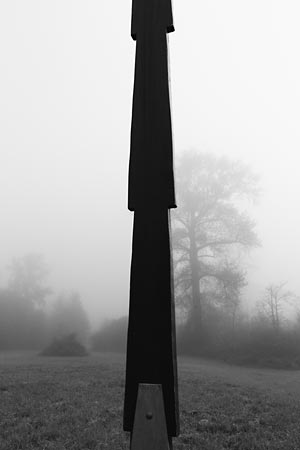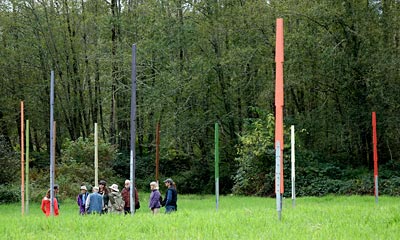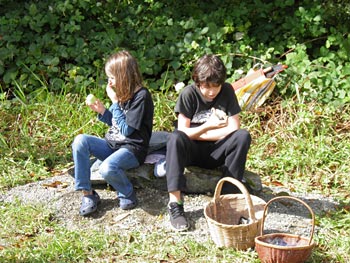A long-lived Native tradition in our area is the use of watching-places. From these vantage points designated elders would regularly observe the rising and setting of heavenly bodies throughout the year to mark seasons and predict fish runs and harvests. On the edge of the big prairie above the Falls there would have no doubt been one of these places. Mt. Si would have offered the perfect ridgeline to gauge the sky's movement.
 Evoking this tradition, the Mary Louie Project has created such a watching-seat in a protected Meadowbrook meadow, facing the mountain. A set of 'articulated' cedar posts, laid out in the meadow to mark the direction of sunrise through the calendar cycle, can be viewed from the watching place.
Evoking this tradition, the Mary Louie Project has created such a watching-seat in a protected Meadowbrook meadow, facing the mountain. A set of 'articulated' cedar posts, laid out in the meadow to mark the direction of sunrise through the calendar cycle, can be viewed from the watching place.
Calendar terms in Puget Sound Salish are keyed to events in nature, like the ripening of berries, and the time to put away paddles at the beginning of winter, rather than mathematical monthly dates. The installation features 11 cedar markers, each painted a color corresponding to a seasonal period. The semicircle of cedar posts is laid out such that it follows the sunrise swings through its 80 plus degree arc at our latitude.
Mary Louie, a Snoqualmie, died in 1914, at least 100 years old; she was born in the town now called Carnation. She lived most of her life at what is now called Inglewood, along the shores of Lake Sammamish.
Mary Louie was a renowned herbal medicine specialist and midwife and was connected to the seasonal round of travel and resource-gathering in two ways.
First, she would have traveled for much of the year to harvest the botanicals needed in her work. Plants mature or become ready for harvest at different times of the year, in different micro-environments and at different altitudes, a person with specialized knowledge of plants would know where to be when. This sort of planned travel and harvesting, tuned to places and seasons, is the antithesis of the old vision of Native American nomadism as aimless wandering in hope of finding something edible. It is also the antithesis our current expectation of having every resource and food available year round from a stationary home.
 The second connection between Mary Louie and the seasonal round is the community or group approach to harvesting major resources. While an herb doctor might be a specialized gatherer of dozens of plant species, every able-bodied person was expected to help insure the food supply for a village, catching and smoking salmon, digging camas, lily, and fern roots, and picking and drying berries. Thus, in addition to her own work Mary Louie would be traveling much of the year to be near community members as they followed major patterns in the resource cycle.
The second connection between Mary Louie and the seasonal round is the community or group approach to harvesting major resources. While an herb doctor might be a specialized gatherer of dozens of plant species, every able-bodied person was expected to help insure the food supply for a village, catching and smoking salmon, digging camas, lily, and fern roots, and picking and drying berries. Thus, in addition to her own work Mary Louie would be traveling much of the year to be near community members as they followed major patterns in the resource cycle.
At several points of every year, like the late spring camas season, the midsummer blackberry harvest and the early fall preparation for high country journeys for huckleberries, beargrass and mountain goat wool, we would almost certainly find hah-cha-blo, Mary Louie, walking down the cross-summit trail (that became the King County Wagon Road, later the first Sunset Highway), working with and for her relatives, consulting the plants, the weather and the skies to plan for the next season. This road originally crossed one side of a huge burn-maintained gathering prairie, later the world's largest hops farm, which employed Native American labor and hosted hundreds of local and regional indigenous people, adding the seasonal cash source of hop picking to a still-vital traditional yearly round.
 The path and road she would have walked is still there, now a country two-lane road, and the center of the gathering prairie is now Meadowbrook Farm Park. In a meadow beside that road, a few hundred yards from the sites of the Snoqualmies' hops camp and an ancient village, under the face of qelbts, the mountain called "camping place" long before it was named Mount Si, the Mary Louie Project has created this installation to honor the way that Mary Louis and her community would have watched the sky and planned their year.
The path and road she would have walked is still there, now a country two-lane road, and the center of the gathering prairie is now Meadowbrook Farm Park. In a meadow beside that road, a few hundred yards from the sites of the Snoqualmies' hops camp and an ancient village, under the face of qelbts, the mountain called "camping place" long before it was named Mount Si, the Mary Louie Project has created this installation to honor the way that Mary Louis and her community would have watched the sky and planned their year.
Though likely the elders would have been men, Mary, being curious and knowledgeable, would have herself sat on the watching place, and looked out at the markers. Visitors are invited to do the same.
Beginning at the Dike Road information kiosk (Boalch Avenue near the North Bend/Snoqualmie city boundary), this short, flat, informal, all-weather unpaved trail leads through the woods to a hidden meadow with views of Mount Si, and the beautiful art installation commemorating early Snoqualmie medicine woman Mary Louie. Sit at the watching place and contemplate the mountain, the seasons, and the long history of people and this land. Park at the Dike Road Kiosk gravel pullout, and cross Boalch Avenue to start. Click here to download map and trail description

Completed in 2014 by the Mary Louie Project:
Artist- Donald Fels (www.artisthinker.com)
Curator- Kenneth (Greg) Watson
Community Activist- Barbara Jirsa
Funding provided by:
4Culture Site Specific Program
Meadowbrook Farm Preservation Association
City of North Bend
City of Snoqualmie
In Kind Support:
Issaquah Cedar
Pile King
Snoqualmie Tribe
Meadowbrook Farm Preservation Association
Special thanks to:
Charlie Rathbun at 4Culture
Dave Battey, Snoqualmie Valley Historian
Steven Mullen Moses, Director Archaeology & Historic Preservation, Snoqualmie Tribe
Benson Vess, metal fabricator
Patricia Tusa Fels, architect